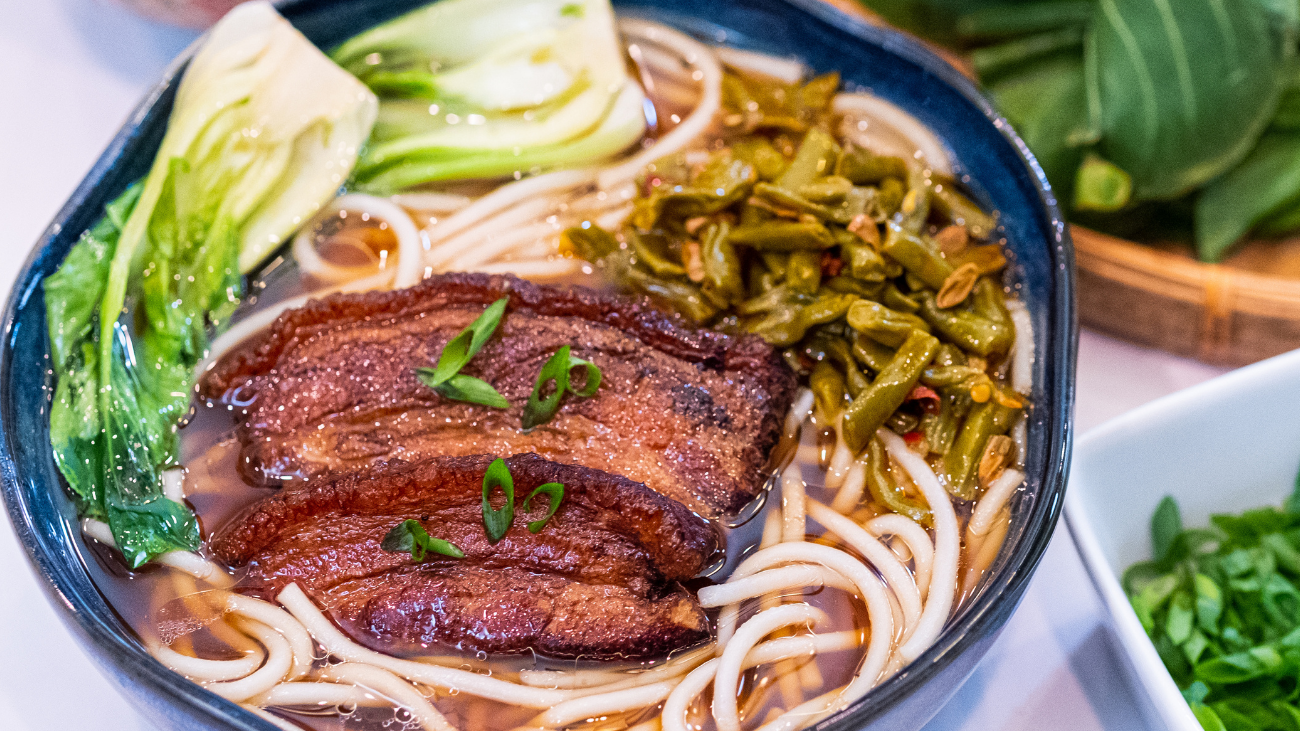Braised Pork Belly Noodle Soup (扣肉米粉)
Rated 3.8 stars by 14 users
Author:
Souped Up Recipes
This is a dish that I had at least a thousand times and the dish that I miss the most ever since I live abroad. The reason it took me this long to share this recipe is that it is not well known. I was worried that the youtube algorithm won’t promote it as much, but you know what? It is so delicious that it deserves attention.

Ingredients
TO BLANCH THE PORK BELLY
-
2 lbs (900 grams) of pork belly
-
4 slices of ginger
-
3 tbsp of Chinese cooking wine
-
1 tsp of Sichuan peppercorns
-
2.5 liters (10 cups) of water
-
2 tsp of dark soy sauce to color the pork
FOR THE SPICE BAG
-
4 slices of dried sand gingers
-
2 cloves
-
A small cinnamon stick
-
½ of a black cardamom
-
3 pieces of dried chili
-
2 tsp of Sichuan peppercorns
-
¼ tsp of fennel seeds
-
5 slices of ginger
-
2 scallions
-
4 cloves of garlic
SEASONING FOR THE BRAISING
-
½ cup of soy sauce
-
½ cup of Chinese cooking wine
-
2.5 tsp of dark soy sauce
-
1 tbsp of sugar
-
2 liters (8 cups) of water
-
2.5 tsp of salt, or to taste
OTHERS
-
14 oz (400 grams) of thick rice noodles
-
⅓ cup of oil to fry the pork belly
-
Baby bok choy or other leafy vegetables
-
Pickled yard beans as a topping
-
Diced scallion as garnish
PRODUCT USED
Directions
Fill a pot with 2.5 liters of water. Add the pork belly, ginger slices, Chinese cooking wine, and Sichuan peppercorns. Bring it to a boil then switch to low heat and let it simmer for 15 minutes.
While waiting, you can put all the spices and aromatics in a spice bag. It is a bit difficult to collect all the spices so it is OK if you miss one or 2. It will not affect the taste that much.
Remove the pork from the pot. Quickly use a fork to poke as many holes on the skin as possible. Wipe all the moisture on the pork by using paper towels. Apply some dark soy sauce on the surface while the pork is still hot. The color doesn’t attach well when it is cold.
Dehydrate the pork skin by using a dehydrator or a fan for a few hours or until the skin feels like leather - very firm and a bit bouncy. If you don’t have a dehydrator or a fan, you can stick the pork belly into the fridge with the skin exposed for 24 hours.
Add 1/3 cup of oil to the wok and heat it to 380 F. Fry the pork until the skin is golden and crispy. Then turn to fry other sides. Be careful with the oil splattering. Suggest putting on the lid when deep frying. You can also do this in an air fryer (8-10 minutes at 400 F).
Let the pork cool then slice it into 2/3 of an inch thick slabs. Add all the pork belly into a clay pot (or any other heavy-duty stockpot) along with the spice bag and the seasonings (soy sauce, Chinese cooking wine, dark soy sauce, and sugar).
Pour in 2 liters of water then bring it to a boil. Add some salt to taste. Simmer on low heat for 1.5 - 2 hours.
Meanwhile, we can prepare the noodles. I am using thick rice noodles. Bring a pot of water to a boil. Turn off the heat. Soak the noodles for 20 minutes. If you soaked the noodles 20 minutes right before the pork is ready, you can transfer the noodles into the clay pot and continue to cook. But if you soaked them way too early and the pork still needs to simmer for a while, you have to transfer the noodles into the cold water so they are not overdone.
When the pork is done simmering, taste the broth again to adjust the flavor. It should be much saltier than your normal taste because we still go lots of noodles and vegetables.
Add the soaked rice noodles and bring them to a boil. Add baby bok choy and let it blanch for 20-30 seconds.
Serve with some spicy pickled long beans (酸豇豆).









































































